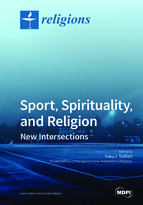Sport, Spirituality, and Religion: New Intersections
A special issue of Religions (ISSN 2077-1444).
Deadline for manuscript submissions: closed (30 June 2019) | Viewed by 41462
Special Issue Editor
Interests: biomedical and social ethics; spiritual and religious health; aging; human enhancement technologies; sport
Special Issues, Collections and Topics in MDPI journals
Special Issue Information
Dear Colleagues,
This Special Issue invites submissions that address the intersection of sport and religion or sport and spirituality. In this issue, we want to identify and probe diverse contemporary questions concerning these intersections. Building on the established body of scholarly work addressing sport, spirituality, and religion, this collection will focus on current and emerging global issues.
Is kneeling during the anthem at NFL games a religious issue? Does it matter if someone experiences a religious or spiritual dimension in sport? What might be some implications for the practice of spiritual care? Is the sports venue ever an appropriate context for religious commitment displays? How might sports be civil religions: hockey in Canada, baseball in the United States, football in the UK or rugby in South Africa, and what is their function in current political climates? Is there a place for sport within formal religions? Why or why not? How might fan spirituality differ and intersect with player spirituality? How do we address fan violence? Doping and enhancement ethics are controversial in sport; how might these sports ethics issues intersect with religion and/or spirituality? How do religious dress issues intersect with sport? What about politics, economic and distributive justice, in relation to religion and sport? Spirituality has been linked to ecojustice and canoeing and whitewater rafting. Are there other connections between spirituality, ecojustice, and sport?
Religion and sport, as cultural expressions, intersect with sexism, gender stereotyping, racism, ableism, ageism, skill-level-ism, and other marginalizing dynamics. It is important to ask how sport currently reflects and informs systemic cultural values including the marginalization and stereotyping of groups. Regardless of the specifis issue you choose to address, you will want to consider how the intersection of sports, religion, and spirituality might generate despair, hope, and possibility.
Prof. Dr. Tracy J. Trothen
Guest Editor
Manuscript Submission Information
Manuscripts should be submitted online at www.mdpi.com by registering and logging in to this website. Once you are registered, click here to go to the submission form. Manuscripts can be submitted until the deadline. All submissions that pass pre-check are peer-reviewed. Accepted papers will be published continuously in the journal (as soon as accepted) and will be listed together on the special issue website. Research articles, review articles as well as short communications are invited. For planned papers, a title and short abstract (about 100 words) can be sent to the Editorial Office for announcement on this website.
Submitted manuscripts should not have been published previously, nor be under consideration for publication elsewhere (except conference proceedings papers). All manuscripts are thoroughly refereed through a double-blind peer-review process. A guide for authors and other relevant information for submission of manuscripts is available on the Instructions for Authors page. Religions is an international peer-reviewed open access monthly journal published by MDPI.
Please visit the Instructions for Authors page before submitting a manuscript. The Article Processing Charge (APC) for publication in this open access journal is 1800 CHF (Swiss Francs). Submitted papers should be well formatted and use good English. Authors may use MDPI's English editing service prior to publication or during author revisions.
Keywords
- sport
- spirituality
- religion
- flow
- justice
- intersectionality






